You came here to see and read about the 10 best houseplants with red leaves. This list is not going to disappoint you.
I have listed my top ten beautiful red indoor plants below, including care tips.
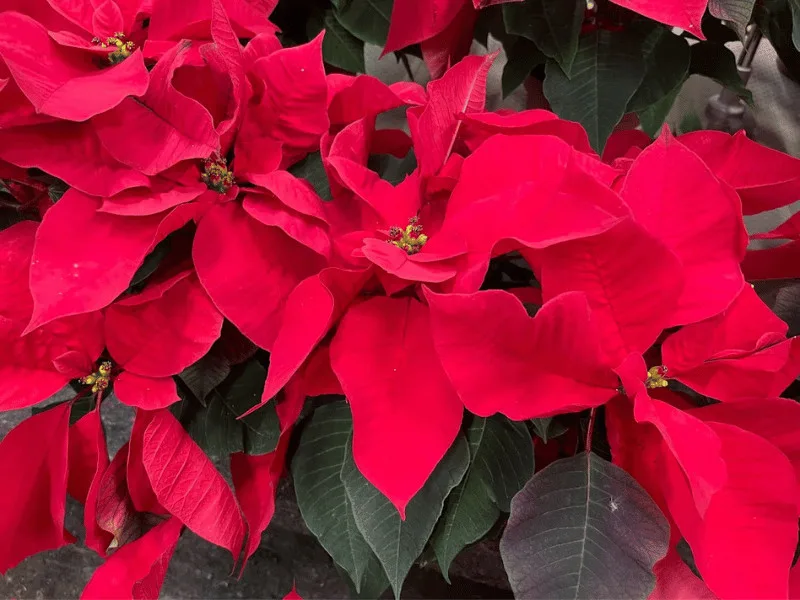
Table of Contents
10 Best Houseplants With Red Leaves
- Poinsettia (Euphorbia pulcherrima)
- Angel Wings (Caladium ‘Red flash’)
- Red Aglaonema (Aglaonema sp)
- Coleus (Solenostemon)
- Hawaiian Ti plant (Cordyline Fruticosa)
- Red Fittonia (Fittonia Vershaffeltii)
- Polka dot plant (Hypoestes Phyllostachys)
- Red star Dracaena (Cordyline australis ‘Red star’)
- Rex Begonia (Rex Begonia ‘Red kiss’)
- Coral Bells ( Heuchera ‘forever red’)
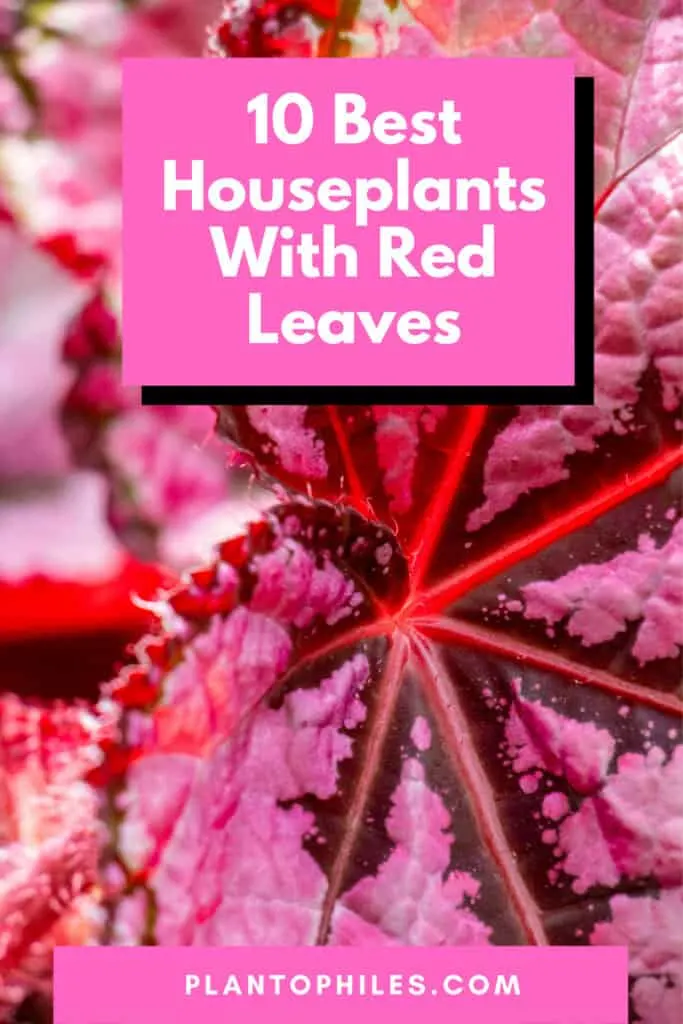
1. Poinsettia – Has fiery red bracts that are modified leaves
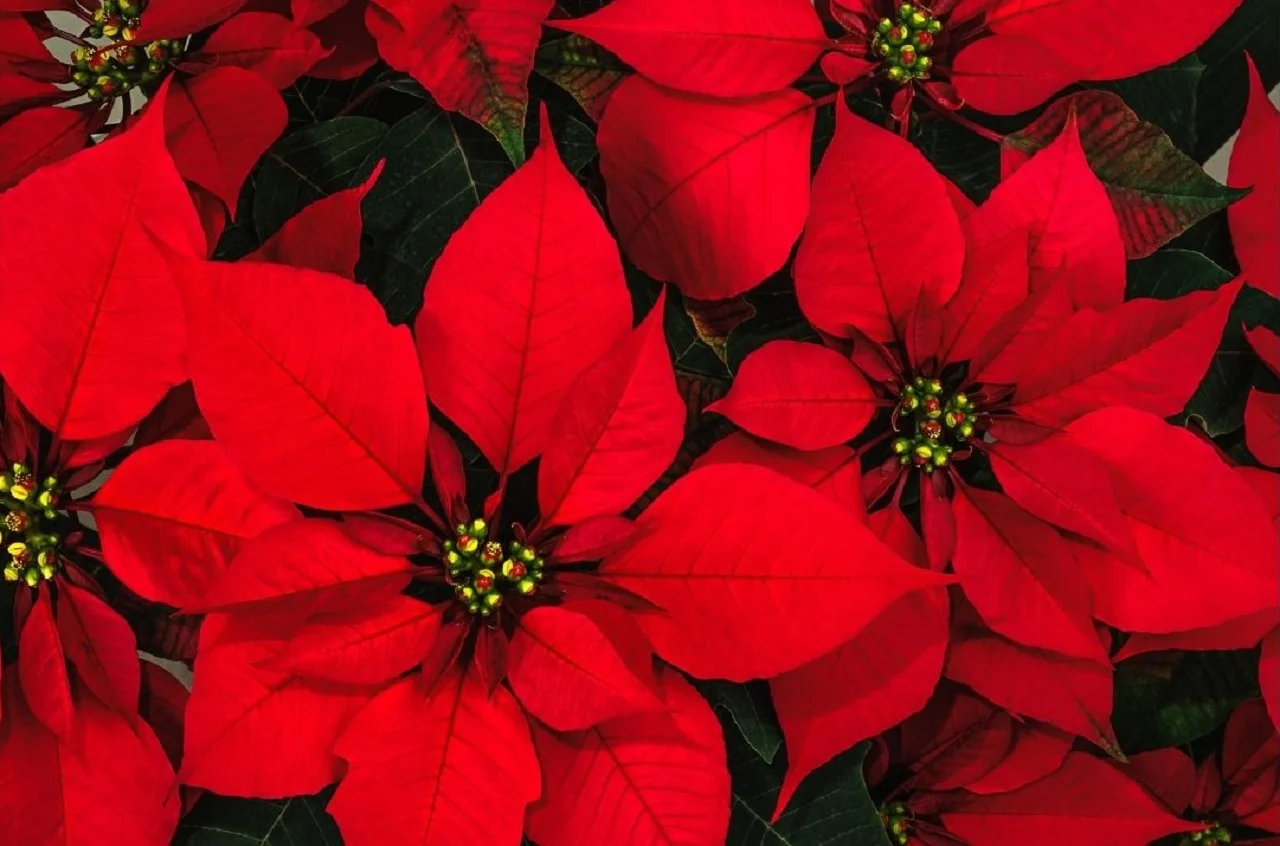
The Poinsettia makes for a great decorative piece during Christmas! They grow up to 12 to 24 inches(30 to 60 cm), just the perfect height for indoor plants.
With their bright red foliage, these plants instantly brighten up your day and change the mood of the space they occupy.
Topping off the list for Poinsettia care is keeping Poinsettias away from places with temperatures below 50℉ (10℃).
They thrive best in temperatures ranging from 65 to 70℉ (18 to 20℃) during the day and 55-65℉ (12-18℃) during the night.
They survive in places with relatively high humidity and abundant bright light.
They also grow best in organic, loose, and sterile soil. While watering the plant, ensure it is neither sitting on a pool of water nor becoming too dry.
You can prune them by the end of April. Also, your plant will be fine as long as it feels loved!
2. Caladium ‘Red Flash’ – Caladium Plants have Intensely Colored Leaves

Known as the Caladium “Red flash,” this plant is known for its big, olive-green, heart-shaped leaves.
I mean, the names that this plant goes by should be enough to pique your curiosity.
Even more interesting is their deep red veins with cute little pink spots all over their leaves.
Regarding their placement, these plants do well under partial to full shade.
For best results, you can place the plant under direct sunlight for 2 to 3 hours (preferably in the morning). After which, keep it in the shade for the next few hours.
Remember that the plant must not completely dry out at any given time.
Check the topsoil to see if you need to provide the Red Flash with more moisture. A rich, slightly acidic soil type works best for this plant.
Also, it prefers to have both the air surrounding it and the soil is slightly moisture-laden.
The ideal temperature for these plants to grow should be above 68℉ (20℃).
This plant is simple to care for as long as you stick by these prerequisites.
3. Red Aglaonema

The Red Aglaonema is arguably the easiest plant to grow indoors! Aglaonemas generally are easy care houseplants, according to the International Aroid Society.
I am not sure my Aglaonema Pictum Tricolor would agree. But there are exceptions to every rule, I suppose.
Their bright red and green patterned leaves look perfect on the coffee table or by your bedroom window.
These plants thrive the best in indirect sunlight and temperatures ranging from 65 to 75℉(18 to 24℃).
When watering this plant, ensure the soil remains moist but not too soggy.
The soil must also be slightly loose and rich in nitrogen.
Overall, this plant is versatile and thrives in all climatic zones. But they sure do like humidity, so place your plant in a room with not less than 50% humidity, and you should be good.
Fun fact—Aglaonemas are exceptional air purifiers.
4. Coleus – Come in many Colors. Many with Red Leaves

Coleus are available in a multitude of colors to choose from. They range from magenta to pink, bright red, and many more!
Aesthetically pleasing and easy to maintain, these plants could easily be gifted to a loved one.
The best way to cultivate them is by using well-draining soil to plant them in.
Feed Coleus with a careful mixture of fertilizers for the best results.
Coleus also needs to be kept under the sun partially, then in the shade for the remainder of the day. These plants love living in warm weather as they don’t stand well in the cold.
They need moist and well-drained soil that is loose in texture with a pH level ranging from 6 to 7.
5. Red Fittonia Nerve Plant – Fittonia albivenis
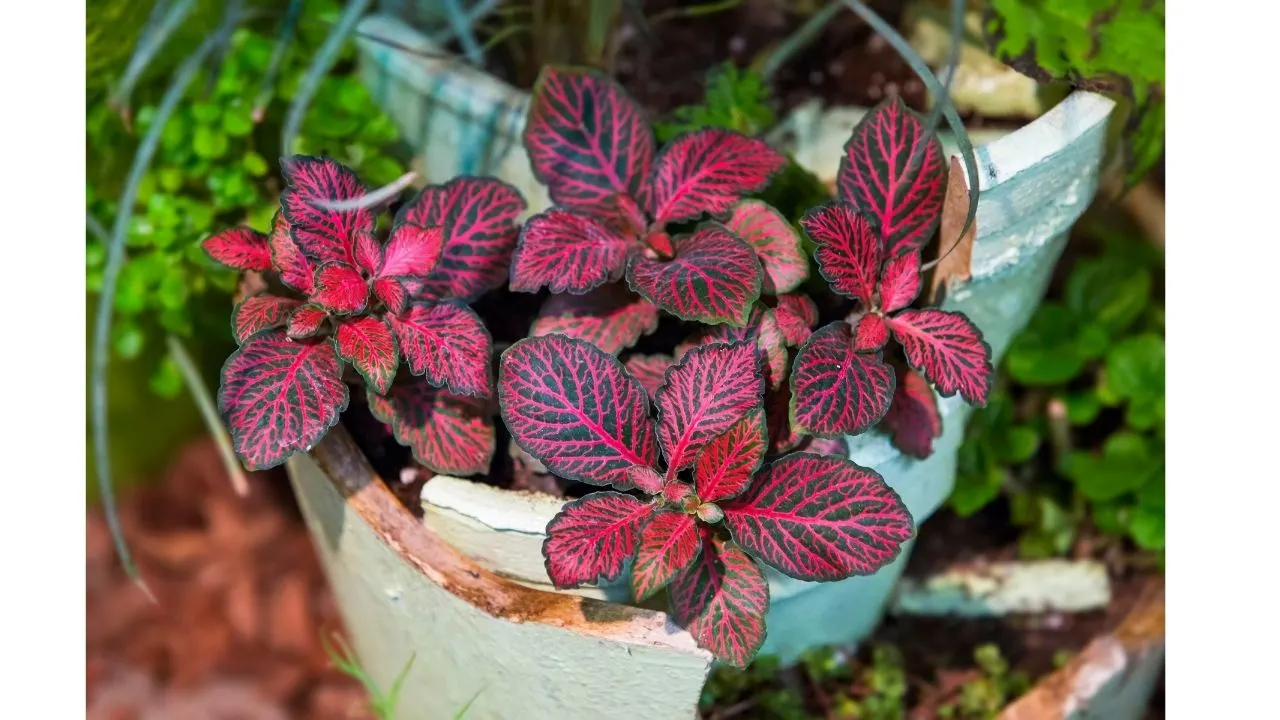
These cute plants look spectacular because of the bright pinkish-red veins on their deep green-colored leaves.
Small and easy to carry, these plants could also be a part of your car decor.
Generally, this plant does well under highly humid conditions.
Avoid placing them in direct sunlight and pot them in slightly acidic soil. Make sure that the soil’s well-drained and moist as well.
Water requirements for this plant are in the moderate zone. But avoid overwatering as it will cause the roots to rot, causing spots to appear on the Fittonia leaves.
If you want, you can use fertilizers (dilute and well-balanced) once every two months.
Pro tip: Use room water temperature water so the plant does not get into shock.
6. Polka dot plant – Hypoestes phyllostachya
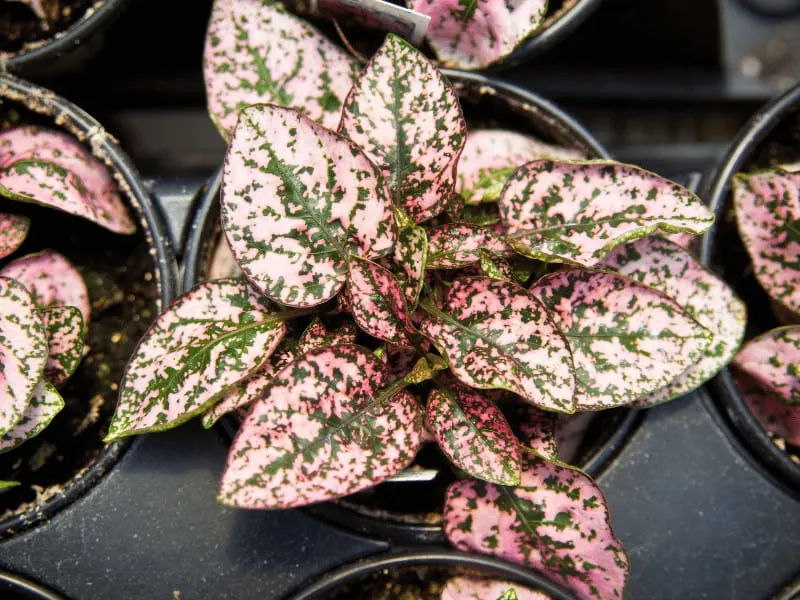
This Polka dot plant – Hypoestes phyllostachya is known for the red spots on its deep green leaves that instantly add a splash of color to your living space.
These indoor plants thrive best in indirect sunlight. However, every 10 to 15 days, place them in direct sunlight to get deeper shades of red in the imperfections.
A word of caution, though. This method can cause the canes to grow in length and get soggy.
To avoid this from happening, you can cut the canes.
This plant thrives best in well-drained and organically rich soil. They also grow quite well in humid areas with 60℉ (16℃) temperatures.
Ensure not to over-water these plants even if you need to maintain the soil’s moisture.
7. Red Star Dracaena – Cordyline australis ‘Red Star’
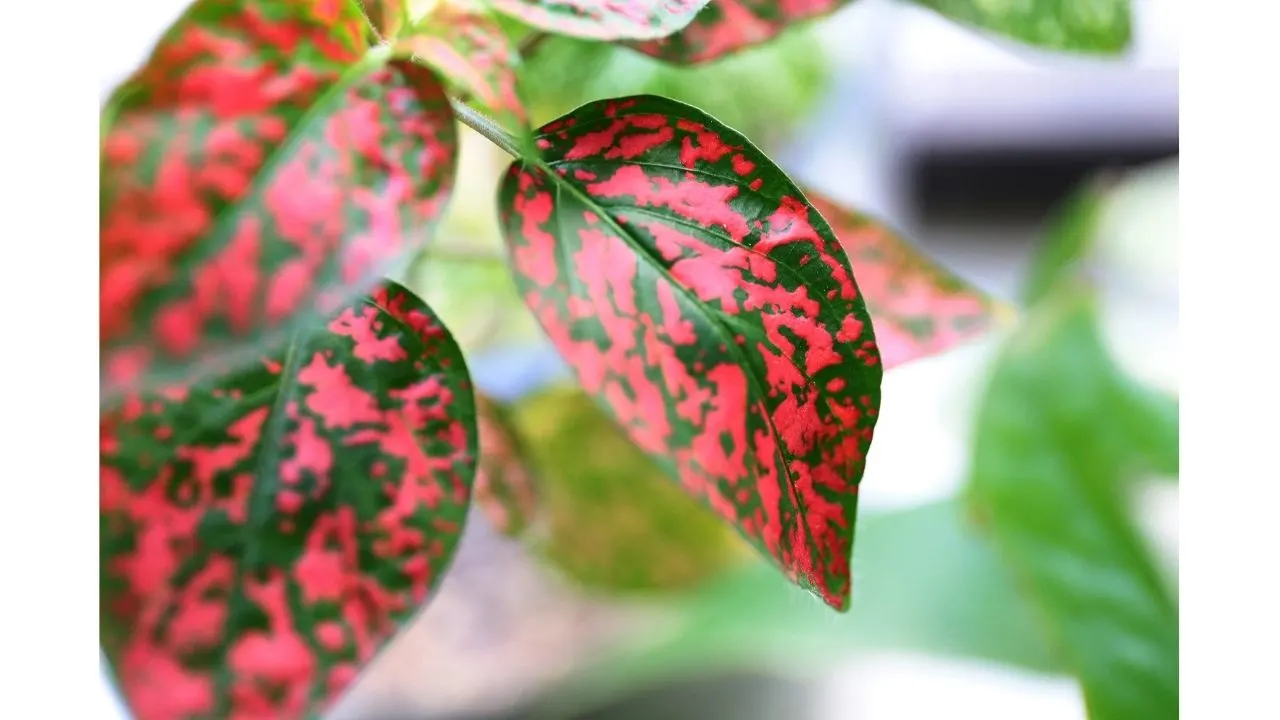
Red Star Dracaena – Cordyline australis ‘Red Star’ have leaves resembling swords with deep shades of red, making them look spectacular.
They grow at a medium pace, making it possible for you to care for them in the best way possible.
The Red star should be near a South-facing window to produce the best results. This is because these plants prefer rich, well-drained soil and indirect sunlight.
However, ensure you don’t overwater your plant when watering. You can even try using a fluoride-free water source to be cautious.
Also, these plants are not very cold-hardy. They cannot withstand temperatures below 30° to 40°F (-1° to 4°C).
8. Painted-Leaf Begonia – Rex Begonia

Popularly known as Red Kiss, Painted-Leaf Begonia or Rex Begonia captivate everyone with their magnificent foliage.
These plants have deep and dark red leaves with a beautiful and artistic black outline.
This very fact makes it look different from most indoor plants.
To maintain its unique color, keep the plant in partial light and pot it in well-drained soil.
Just make sure to use soil that has rich but loose soil textures. These plants prefer growing in soil with those conditions mentioned.
Also, they grow best under high humidity conditions under room temperature not exceeding 65 to 75℉ (18 to 23℃).
Do not mist the plant to avoid powdery mildew.
Water the plant when the soil starts getting dry as much as possible. Otherwise, the leaves will begin to droop.
Nobody wants the Rex Begonia to shrivel up, right?
9. Hawaiian Ti Plant– Cordyline fruticosa
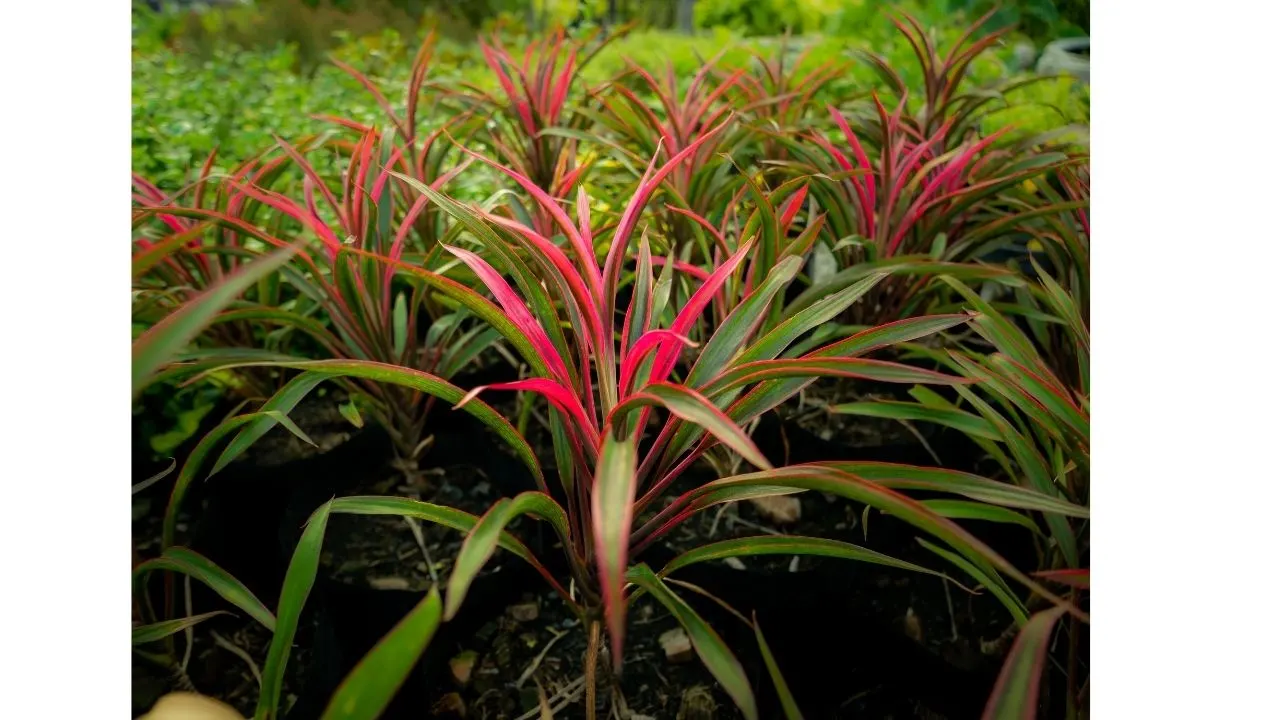
Hawaiian Ti Plant or Cordyline fruticosa has deep, burgundy-shaded leaves diversified with bright pink and red shades.
They’re generally easy to tend to and look stunning when potted in a white porcelain pot.
You could place it on the balcony or in the living room.
To watch it bloom to its fullest, keep it away from the sun’s direct rays.
This plant loves humidity. Hence, ensure the soils moist but not over-flooded with water.
The Hawaiian Ti plant thrives in full to partial sunlight with temperatures ranging from 60 to 80 ℉ (15 to 26℃).
It does not usually need fertilizers, but you could add some in the Summer months.
10. Coral Bells – Heuchera

Also known as the “forever red,” Coral Bells or Heuchera have bright and deep red foliage that’s enough to captivate onlookers for a little while.
Caring for the Heuchera is very simple. These plants do well under full sunlight as well as in the shade.
They mostly prefer growing in moist soil that’s slightly acidic.
I water my Coral Bells once weekly (more frequently during summer), and they are doing fine!
Please take my advice. Make sure to place your plant near an east-facing window or opening. This is for its brightness requirements and adds to its aesthetic value!
To avoid encountering problems with the Heuchera, provide it with enough airflow and properly draining soil. This will avoid adding too much moisture to the soil where the plant lives.
FAQ
How do you take care of a Poinsettia after the Christmas season?
The location where you plan to place your poinsettias should receive at least 6 hours of bright but indirect sunlight every day.
Also, in mid-April, place the plant in a sunny location after trimming the stems to 6-8 inches in length.
You can also use liquid fertilizer to meet the plant’s mineral requirements, especially with calcium. But remember to use fertilizer only after you have seen new growth.
Conclusion
I hope after reviewing the plants you agree that the 10 best houseplants with red leaves are fire 😉

Daniel has been a plant enthusiast for over 20 years. He owns hundreds of houseplants and prepares for the chili growing seasons yearly with great anticipation. His favorite plants are plant species in the Araceae family, such as Monstera, Philodendron, and Anthurium. He also loves gardening and is growing hot peppers, tomatoes, and many more vegetables.


